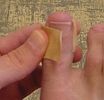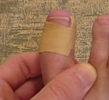- Conservative treatment of ingrown toe nails
-
Ingrown nail Classification and external resources 
ICD-10 L60.0 ICD-9 703.0 DiseasesDB 29440 eMedicine emerg/593 ped/942 This article describes all known (proved or unproved) conservative treatments of ingrown toe nails.
Contents
Conservative methods in general
Treatment of ingrown toenails ranges from soaking the afflicted area to surgery. The appropriate method is dictated by the severity of the condition. In nearly all cases, drainage of blood or watery discharge should mean a trip to the doctor, usually a podiatrist, a specialist trained explicitly to treat these conditions. Most practitioners agree that trying to outwait the condition is nearly always fruitless, as well as agonizing, but it can be done as long as the condition is not too severe and if the individual has a high pain threshold. Unfortunately, many consider that dealing with the nail is the correct way to cure the "ingrown" toenail. This is often incorrect. Ingrown toenails are often the result of a bacterial infection. If the infection is dealt with, the toe (and toenail) will heal itself.
Soaking the affected toe in an anti-bacterial solution for 30 minutes at a time over a period of a few days or taking a course of erythromycin can clear up the infection allowing the toe to heal. Prying up the toenail will often make the infection worse and lead to further inflammation. The best way to deal with it is to leave the nail alone (no squeezing, pressing, lifting) and deal exclusively with the infection. In mild cases daily soaking of the affected digit in a mixture of warm water and Epsom salts and applying an over-the-counter antiseptic might allow the nail to grow out so it may be trimmed properly and the flesh to heal. Note that infection may be somewhat difficult to prevent in cleaning and treating ingrown nails owing to the warm, dark, and damp environment in shoes. Peroxide is immediately effective to help clean minor infections but iodine is more effective in the long term as it continues to prevent bacterial growth even after it is dry. However, iodine should not be used on deep wounds. In such cases a physician or podiatrist should be consulted.
Although bandages can help keep out bacteria, it is not advisable to apply any of the new types of spray-on bandages to ingrown nails that show any discharge - preventing drainage will likely cause intense swelling and pain. Removal of spray-on bandages can be achieved with common rubbing alcohol. Some have advocated placing a small piece of cotton under the nail, specifically the affected area or as close to it as possible. In mild or moderate cases this may help the nail to grow back out from underneath the skin. But other foot doctors warn against the practice as many patients report that it increases spread of infection.[1] This solution is ineffective in advanced cases and usually only works in the early stages.
Some doctors will apply silver nitrate to granulation tissue (overgrowth of irritated tissue at the side of the nail. This may look like reddish cauliflower, bleeds easily). This may [decrease?] the inflammation of the affected tissue at the side of the nail. Never ever attempt to alleviate the swelling using a needle, doing so can lead to an infection. If the infection is dealt with, the toe (and toenail) will heal itself. Soaking the affected toe in an anti-bacterial solution (such as colloidal silver or monatomic silver) for 30 minutes at a time over a period of a few days or taking a course of erythromycin can clear up the infection allowing the toe to heal.
Footwear is a breeding ground for the bacteria that causes the infection. Socks should be changed at minimum daily, and removed at night to allow the toe to be kept cool and dry. Shoes should be kept dry and treated with an anti-bacterial shoe product to keep bacteria growth at a minimum. In serious cases these home remedies may be ineffective. When the flesh is excessively swollen and infected (purple skin around natural skin tone) these procedures may not work. These more severe cases where the area around the nail becomes infected, or the nail will not grow back properly, must be treated by a professional.
Another way to deal with the ingrown toenail is to get the portion of your toenail which is growing under the skin removed. This must be performed by a podiatrist. The procedure is usually performed after administering a local anesthetic. Once the toe is numb the podiatrist will be able to remove the offending nail border. Once the nail is removed the nail matrix (aka nail root) can either be destroyed via chemical means by using phenol, or surgically by excising the nail matrix. After either procedure the nail will have to be dressed daily with antibiotic cream and a dressing. The goal of these procedures is to permanently remove the nail border that becomes ingrown, and should prevent ingrowns from happening again. Of the two procedures the surgical procedure usually has a better outcome than the chemical one.
Several variations of these procedures are outlined below.
Band-Aid method
This method is non-invasive. The theory is that by physically pulling the side of the nailbed away from the nail, one can decrease pressure while simultaneously improving drainage of accumulated pus and drying of the wound. Digit should be clean and unoiled by ordinary soap for best adhesion of Band-Aid. The pulling is achieved with an ordinary or elastic adhesive bandage. A user of this method sticks one side of the bandage securely to the immediate area of the nailbed, pulling suitably as the bandage is wound around the digit at an angle so that the other end overlaps the first, but does not cover the wound itself. Thus the second side secures the first and keeps it from coming loose under the tension. Loosening while walking can be a problem but there are other ways to fix the bandage.
- Application of Band-Aid (wound on right side of nail)
See also
Footnotes and References
- ^ "FootPhysicians.com Information on Ingrown Toenails". http://www.footphysicians.com/footankleinfo/ingrown-toenail.htm. Retrieved 31 March 2010.
- Chapeskie H (2008). "Ingrown toenail or overgrown toe skin?". Canadian Family Physician 54 (11): 1561–1562. PMC 2592332. PMID 19005128. http://www.cfp.ca/cgi/content/full/54/11/1561?maxtoshow=&HITS=10&hits=10&RESULTFORMAT=&author1=Chapeskie&andorexactfulltext=and&searchid=1&FIRSTINDEX=0&sortspec=relevance&resourcetype=HWCIT.
- Vandenbos KQ, Bowers WP (1959). "Ingrown toenail: a result of weight bearing on soft tissue". US Armed Forces Medical Journal 10 (10): 1168–1173. http://www.ingrowntoenails.ca/images/vanderbos/article.htm.
- Pearson HJ, Bury RN, Wapples J, Watkin DF (1987). "Ingrowing toenails: is there a nail abnormality? A prospective study". J Bone Joint Surg Br 69 (5): 840–842. PMID 3680356. http://www.jbjs.org.uk/cgi/reprint/69-B/5/840.
- Aksakal AB, Ozsoy E, Gürer M (2003). "Silicone gel sheeting for the management and prevention of onychocryptosis". Dermatol Surg 29 (3): 261–4. doi:10.1046/j.1524-4725.2003.29061.x. PMID 12614420. http://www.blackwell-synergy.com/openurl?genre=article&sid=nlm:pubmed&issn=1076-0512&date=2003&volume=29&issue=3&spage=261.
- Boll OF (1945). "Surgical correction of ingrowing toenails". J Natl Assoc Chiroprod. 35: 8–9.
- Kominsky SJ, Daniels MD (2000). "A modified approach to the phenol and alcohol chemical partial matrixectomy". J Am Podiatr Med Assoc 90 (4): 208–10. PMID 10800276. http://www.japmaonline.org/cgi/pmidlookup?view=long&pmid=10800276.
- Rounding C, Bloomfield S (2005). Rounding, Catherine. ed. "Surgical treatments for ingrowing toenails". Cochrane Database Syst Rev (2): CD001541. doi:10.1002/14651858.CD001541.pub2. PMID 15846620.
- Boberg JS, Frederiksen MS, Harton FM (2002). "Scientific analysis of phenol nail surgery". J Am Podiatr Med Assoc 92 (10): 575–9. PMID 12438504. http://www.japmaonline.org/cgi/pmidlookup?view=long&pmid=12438504.
External links
- "Ingrown Toenails" Information regarding ingrown toenails and a detailed description of the Vandenbos procedure including pictures, research articles and a video of the procedure
- "Nail Surgery" Chapter 33 of Textbook of Hallux Valgus and Forefoot Surgery, complete text online in PDF file
- "Complete Nail Surgery Photos Photos and comments showing a full nail removal from beginning to end.
- Ingrown toenail
Disorders of skin appendages (L60–L75, 703–706) Nail behavior: Onychotillomania · Onychophagiaother: Ingrown nail · Anonychiaungrouped: Paronychia (Acute paronychia, Chronic paronychia ) · Chevron nail · Congenital onychodysplasia of the index fingers · Green nails · Half and half nails · Hangnail · Hapalonychia · Hook nail · Lichen planus of the nails · Longitudinal erythronychia · Malalignment of the nail plate · Median nail dystrophy · Mees' lines · Melanonychia · Muehrcke's lines · Nail–patella syndrome · Onychoatrophy · Onychocryptosis · Onycholysis · Onychomadesis · Onychomatricoma · Onychomycosis · Onychophosis · Onychoptosis defluvium · Onychorrhexis · Onychoschizia · Platonychia · Pincer nails · Plummer's nail · Psoriatic nails · Pterygium inversum unguis · Pterygium unguis · Purpura of the nail bed · Racquet nail · Red lunulae · Shell nail syndrome · Splinter hemorrhage · Spotted lunulae · Staining of the nail plate · Stippled nails · Subungual hematoma · Terry's nails · Twenty-nail dystrophyHair noncicatricial alopecia: Alopecia/Alopecia areata (Alopecia totalis, Alopecia universalis, Ophiasis)
Androgenic alopecia (male-pattern baldness) · Hypotrichosis · Telogen effluvium · Traction alopecia · Lichen planopilaris · Trichorrhexis nodosa · Alopecia neoplastica · Anagen effluvium · Alopecia mucinosacicatricial alopecia: Pseudopelade of Brocq · Central centrifugal cicatricial alopecia · Pressure alopecia · Traumatic alopecia · Tumor alopecia · Hot comb alopecia · Perifolliculitis capitis abscedens et suffodiens · Graham-Little syndrome · Folliculitis decalvansHirsutism · Acquired generalized hypertrichosis · Generalized congenital hypertrichosis · Localized acquired hypertrichosis · Localized congenital hypertrichosis · Patterned acquired hypertrichosis · Prepubertal hypertrichosis · X-linked hypertrichosisAcneAcne vulgaris · Acne conglobata · Acne miliaris necrotica · Tropical acne · Infantile acne/Neonatal acne · Excoriated acne · Acne fulminans · Acne medicamentosa (e.g., steroid acne) · Halogen acne (Iododerma, Bromoderma, Chloracne) · Oil acne · Tar acne · Acne cosmetica · Occupational acne · Acne aestivalis · Acne keloidalis nuchae · Acne mechanica · Acne with facial edema · Pomade acne · Acne necrotica · Blackhead · Lupus miliaris disseminatus facieiPerioral dermatitis (Granulomatous perioral dermatitis) · Phymatous rosacea (Rhinophyma, Blepharophyma, Gnathophyma, Metophyma, Otophyma) · Papulopustular rosacea · Lupoid rosacea · Erythrotelangiectatic rosacea · Glandular rosacea · Gram-negative rosacea · Steroid rosacea · Ocular rosacea · Persistent edema of rosacea · Rosacea conglobata · variants (Periorificial dermatitis, Pyoderma faciale)UngroupedGranulomatous facial dermatitis · Idiopathic facial aseptic granuloma · Periorbital dermatitis · SAPHO syndromeFollicular cystsFolliculitis (Folliculitis nares perforans, Tufted folliculitis) · Pseudofolliculitis barbae
Hidradenitis (Hidradenitis suppurativa, Recurrent palmoplantar hidradenitis, Neutrophilic eccrine hidradenitis)UngroupedAcrokeratosis paraneoplastica of Bazex · Acroosteolysis · Bubble hair deformity · Disseminate and recurrent infundibulofolliculitis · Erosive pustular dermatitis of the scalp · Erythromelanosis follicularis faciei et colli · Hair casts · Hair follicle nevus · Intermittent hair–follicle dystrophy · Keratosis pilaris atropicans · Kinking hair · Koenen's tumor · Lichen planopilaris · Lichen spinulosus · Loose anagen syndrome · Menkes kinky hair syndrome · Monilethrix · Parakeratosis pustulosa · Pili (Pili annulati · Pili bifurcati · Pili multigemini · Pili pseudoannulati · Pili torti) · Pityriasis amiantacea · Plica neuropathica · Poliosis · Rubinstein–Taybi syndrome · Setleis syndrome · Traumatic anserine folliculosis · Trichomegaly · Trichomycosis axillaris · Trichorrhexis (Trichorrhexis invaginata · Trichorrhexis nodosa) · Trichostasis spinulosa · Uncombable hair syndrome · Wooly hair · Wooly hair nevusSweat glands Miliaria (Colloid milium • Miliaria crystalline • Miliaria profunda • Miliaria pustulosa • Miliaria rubra • Occlusion miliaria • Postmiliarial hypohidrosis), Granulosis rubra nasi, Ross’ syndrome, Anhidrosis, Hyperhidrosis (Generalized, Gustatory, Palmoplantar)Body odor, Chromhidrosis, Fox–Fordyce diseaseCategories:- Conditions of the skin appendages
- Podiatry
Wikimedia Foundation. 2010.




